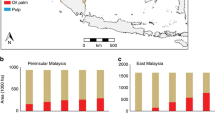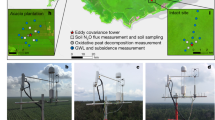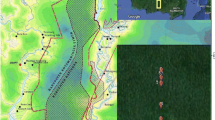Abstract
Tropical peat swamp forests, which are predominantly located in Southeast Asia (SEA) and play a prominent role as a global carbon store, are being intensively degraded and converted to agricultural lands and tree plantations. For national inventories, updated estimates of peat emissions of greenhouse gases (GHG) from land use (LU) and land-use change in the tropics are required. In this context, we reviewed the scientific literature and calculated emission factors of peat net emissions of carbon dioxide (CO2), methane (CH4) and nitrous oxide (N2O) in seven representative LU categories for SEA i.e. intact peat swamp forest, degraded forest (logged, drained and affected by fire), mixed croplands and shrublands, rice fields, oil palm, Acacia crassicarpa and sago palm plantations. Peat net CO2 uptake from or emissions to the atmosphere were assessed using a mass balance approach. The balance included main peat C inputs through litterfall and root mortality and outputs via organic matter mineralization and dissolved organic carbon. Peat net CO2 loss rate from degraded forest, croplands and shrublands, rice fields, oil palm, A. crassicarpa and sago palm plantations amounted to 19.4 ± 9.4, 41.0 ± 6.7, 25.6 ± 11.5, 29.9 ± 10.6, 71.8 ± 12.7 and 5.2 ± 5.1 Mg CO2 ha−1 y−1, respectively. Total peat GHG losses amounted to 20.9 ± 9.4, 43.8 ± 6.8, 36.1 ± 12.9, 30.4 ± 10.6, 72 ± 12.8 and 8.6 ± 5.3 Mg CO2-equivalent ha−1 y−1 in the same LU categories, respectively. A single land-clearing fire would result in additional emissions of 493.6 ± 156.0 Mg CO2-equivalent ha−1.


Similar content being viewed by others
References
Anshari GZ, Afifudin M, Nuriman M, Gusmayanti E, Arianie L, Susana R, Nusantara RW, Sugardjito J, Rafiastanto A (2010) Drainage and land use impacts on changes in selected peat properties and peat degradation in West Kalimantan Province, Indonesia. Biogeosciences 7:3403–3419
Arai S, Ishizuka S, Ohta S, Ansori S, Tokuchi N, Tanaka N, Hardjono A (2008) Potential N2O emissions from leguminous tree plantation soils in the humid tropics. Global Biogeochem Cycles 22, GB2028. doi:10.1029/2007GB002965
Basuki S, Suwardi, Munoz CP (2012) Emission of CO2 and CH4 from plantation forest of Acacia crassicarpa on peatlands in Indonesia. Paper presented at the 14th International peat congress, Stockholm, Sweden, 3–8 June 2012
Boehm H-DV, Siegert F, Rieley JO, Page SE, Jauhiainen J, Vasander H, Jaya A (2001) Fire impact and carbon release on tropical peatlands in Central Kalimantan, Indonesia. Proceedings ACRS 2001–22nd Asian conference on remote sensing, 5–9 November 2001, Singapore 1, 538–543
Borenstein M, Hedges LV, Rothstein H (2009) Fixed effect versus random effects models. In: Borenstein M, Hedges LV, Higgins JPT, Rothstein HR (eds) Introduction to meta-analysis, statistics in practice series. John Wiley and Sons, Ltd., Cambridge
Bouillet JP, Laclau JP, Gonçalves JLM, Moreira MZ, Trivelin PCO, Jourdan C, Silva EV, Piccolo MC, Tsai SM, Galiana A (2008) Mixed-species plantations of Acacia mangium and Eucalyptus grandis in Brazil 2: nitrogen accumulation in the stands and biological N2 fixation. Forest Ecol Manage 255:3918–3930
Carlson KM, Curran LM, Asner GP, McDonald Pittman A, Trigg SN, Adeney JM (2012a) Carbon emissions from forest conversion by Kalimantan oil palm plantations. Lett Nat Climate Change. doi:10.1038/NCLIMATE1702
Carlson KM, Curran LM, Ratnasari D, Pittman AM, Soares-Filho BS, Asner GP, Trigg SN, Gaveau DA, Lawrence D, Rodrigues HO (2012b) Committed carbon emissions, deforestation, and community land conversion from oil palm plantation expansion in West Kalimantan, Indonesia. PNAS. doi:10.1073/pnas.1200452109 (early edition)
Christian TJ, Kleiss B, Yokelson RJ, Holzinger R, Crutzen PJ, Hao WM, Saharjo BH, Ward DE (2003) Comprehensive laboratory measurements of biomass-burning emissions: 1. Emissions from Indonesian, African, and other fuels. J Geophys Res 108. doi:10.1029/2003JD003704
Chu H, Hosen Y, Yagi K (2007) NO, N2O, CH4 and CO2 fluxes in winter barley field of Japanese Andisol as affected by N fertilizer management. Soil Biol Biochem 39:330–339. doi:10.1016/j.soilbio.2006.08.003
Comeau L-P, Hergoualc’h K, Smith J, Verchot LV (2013) Conversion of intact peat swamp forest to oil palm plantation: effects on soil CO2 fluxes in Jambi, Sumatra. Working Paper 110. CIFOR, Bogor, Indonesia
Crutzen PJ, Mosier AR, Smith KA, Winiwarter W (2007) N2O release from agro-biofuel production negates global warming reduction by replacing fossil fuels. Atmos Chem Phys Discuss 7:11191–11205
Dariah A, Marwanto S, Agus F (2013) Peat CO2 emissions from oil palm plantations, separating root-related and heterotrophic respirations. Submitted to Mitigation and adaptation strategies for global change (this issue)
Dendooven L, Patiño-Zúñiga L, Verhulst N, Luna-Guido M, Marsch R, Govaerts B (2012) Global warming potential of agricultural systems with contrasting tillage and residue management in the central highlands of Mexico. Agric Ecosyst Environ 152:50–58
FAO, IIASA, ISRIC, ISSCAS, JRC (2009) Harmonized world soil database (version 1.1). FAO, Rome, Italy and IIASA, Laxenburg
Forster P, Ramaswamy V, Artaxo P, Berntsen T, Betts R, Fahey DW, Haywood J, Lean J, Lowe DC, Myhre G, Nganga J, Prinn R, Raga G, Schulz M, van Dorland R (2007) Changes in atmospheric constituents and in radiative forcing. In: Solomon S, Qin D, Manning M, Chen Z, Marquis M, Averyt KB, Tignor M, Miller HL (eds) Climate Change 2007: The Physical Science Basis. Contribution of Working Group I to the Fourth Assessment Report of the Intergovernmental Panel on Climate Change. Cambridge University Press, Cambridge
Frolking S, Talbot J, Jones MC, Treat CC, Kauffman JB, Tuittila E-S, Roulet N (2011) Peatlands in the Earth’s 21st century climate system. Environ Rev 19:371–396
Furukawa Y, Inubushi K, Ali M, Itang AM, Tsuruta H (2005) Effect of changing groundwater levels caused by land-use changes on greenhouse gas fluxes from tropical peat lands. Nutr Cycl Agroecosyst 71:81–91
Gusmayanti E (2012) Sago palm and its potential roles in mitigating carbon emission from West Kalimantan peatland. Poster presented at the International workshop Assessment of wetland change in West Kalimantan province: Does it enhance sustainability? Pontianak, Indonesia, 17–19 September 2012
Hadi A, Inubushi K, Furukawa Y, Purnomo E, Rasmadi M, Tsuruta H (2005) Greenhouse gas emissions from tropical peatlands of Kalimantan, Indonesia. Nutr Cycl Agroecosyst 71:73–80
Henson IE, Betitis T, Tomda Y, Chase LDC (2012) The estimation of frond base biomass (FBB) of oil palm. J Oil Palm Res 24:473–1479
Hergoualc’h K (2011) Principles and methods for assessing climate change mitigation as an ecosystem service in agroecosystems. In: Rapidel B, DeClerck F, Le Coq J-F, Beer J (eds) Ecosystem services from agriculture and agroforestry. Measurement and payment. Earthscan, London
Hergoualc’h K, Verchot LV (2011) Stocks and fluxes of carbon associated with land-use change in Southeast Asian tropical peatlands: a review. Glob Biochem Cycles 25, GB2001. doi:10.1029/2009GB003718
Hirano T, Jauhiainen J, Inoue T, Takahashi H (2009) Controls on the carbon balance of tropical peatlands. Ecosystems 12:873–887
Hirano T, Segah H, Kusin K, Limin S, Takahashi H, Osaki M (2012) Effects of disturbances on the carbon balance of tropical peat swamp forests. Glob Chang Biol 18:3410–3422. doi:10.1111/j.1365-2486.2012.02793.x
Hooijer A, Page S, Canadell JG, Silvius M, Kwadijk J, Wösten H, Jauhiainen J (2010) Current and future CO2 emissions from drained peatlands in Southeast Asia. Biogeosciences 7:1505–1514
Hooijer A, Page S, Jauhiainen J, Lee WA, Lu XX, Idris A, Anshari G (2012) Subsidence and carbon loss in drained tropical peatlands. Biogeosciences 9:1053–1071
Husnain AF, Wigena P, Maswar DA, Marwanto S (2013) Peat CO2 emissions from several land-use types in Indonesia. Submitted to Mitigation and adaptation strategies for global change (this issue)
Hütsch B, Webster CP, Powlin DS (1993) Long-term effects of nitrogen fertilization on methane oxidation in soil of the Broadbalk wheat experiment. Soil Biol Biochem 25:1307–1315. doi:10.1016/0038-717(93)90045-D
Infinite Earth L (2010) Approved VCS methodology VM0004. Version 1.0. Methodology for conservation projects that avoid planned land use conversion in peat swamp forests. Sectoral Scope 14. Available at http://v-c-s.org/methodologies/VM0004
InfoStat G (2004) InfoStat. FCA, Universidad Nacional de Córdoba, Córdoba
Inubushi K, Furukawa Y, Hadi A, Purnomo E, Tsuruta H (2003) Seasonal changes of CO2, CH4 and N2O fluxes in relation to land-use change in tropical peatlands located in coastal area of South Kalimantan. Chemosphere 52:603–608
IPCC (2003) Good practice guidance for land use, land-use change and forestry. Institute for Global Environmental Strategies (IGES), Japan
IPCC (2006) IPCC guidelines for national greenhouse gas inventories. Institute for Global Environmental Strategies (IGES), Hayama
Ishida T, Suzuki S, Nagano T, Osawa K, Yoshino K, Fukumura K, Nuyim T (2001) CO2 emission rate from a primary peat swamp forest ecosystem in Thailand. Environ Control Biol 39:305–312
Jauhiainen J, Hooijer A (2012) Greenhouse gas emissions from a plantation on thick tropical peat. Paper presented at the 14th International peat congress, Stockholm, Sweden, 3–8 June 2012
Jauhiainen J, Hooijer A, Page SE (2012a) Carbon dioxide emissions from an Acacia plantation on peatland in Sumatra, Indonesia. Biogeosciences 9:617–630
Jauhiainen J, Silvennoinen H, Hämäläinen R, Kusin K, Limin S, Raison RJ, Vasander H (2012b) Nitrous oxide fluxes from tropical peat with different disturbance history and management. Biogeosciences 9:1337–1350
Jungkunst HF, Fiedler S (2007) Latitudinal differentiated water table control of carbon dioxide, methane and nitrous oxide fluxes from hydromorphic soils: feedbacks to climate change. Glob Chang Biol 13:2668–2683
Kakuda K-I, Watanabe A, Ando H, Jong FS (2005) Effects of fertilizer application on the root and aboveground biomass of sago palm (Metroxylon sagu Rottb.) cultivated on peat soil. Jpn J Trop Agric 49:264–269
Konda R, Ohta S, Ishizuka S, Arai S, Ansori S, Tanaka N, Hardjono A (2008) Spatial structures of N2O, CO2, and CH4 fluxes from Acacia mangium plantation soils during a relatively dry season in Indonesia. Soil Biol Biochem 40:3021–3030
Lo E (2005) Gaussian error propagation applied to ecological data: post-ice-storm-downed woody biomass. Ecol Monogr 75:451–466
Manzoni S, Porporato A (2009) Soil carbon and nitrogen mineralization: theory and models across scales. Soil Biol Biochem 41:1355–1379
Marwanto S, Agus F (2013) Variation of CO2 flux, water table, soil moisture, and temperature from an oil palm plantation on peatland in Sumatra, Indonesia. Submitted to Mitigation and adaptation strategies for global change (this issue)
Maswar, Haridjaja O, Sabiham S, Van Noordwijk M (2011) Carbon loss from several land use type on tropical peat lands drained. Jurnal Tanah dan Iklim 34:13–25
Melling L, Goh KJ, Beauvais C, Hatano R (2007a) Carbon flow and budget in a young mature oil palm agroecosystem on deep tropical peat. Paper presented at the International symposium and workshop on tropical peatland, Yogyakarta, Indonesia, 27–31 August 2007
Melling L, Hatano R, Goh KJ (2007b) Nitrous oxide emissions from three ecosystems in tropical peatland of Sarawak, Malaysia. Soil Sci Plant Nutr 53:792–805
Melling L, Chaddy A, Goh KJ, Hatano R (2013) Soil CO2 fluxes from different ages of oil palm in tropical peatland of Sarawak, Malaysia as influenced by environmental and soil properties. Acta Horticult (ISHS) 982:25–35
Miettinen J, Shi C, Liew SC (2011) Influence of peatland and land cover distribution on fire regimes in insular Southeast Asia. Reg Environ Chang 11:191–201
Miettinen J, Hooijer A, Shi C, Tollenaar D, Vernimmen R, Liew SC, Malins C, Page S (2012a) Extent of industrial plantations on Southeast Asian peatlands in 2010 with analysis of historical expansion and future projections. GCB Bioenergy. doi:10.1111/j.1757-1707.2012.01172.x
Miettinen J, Shi C, Liew SC (2012b) Two decades of destruction in Southeast Asia’s peat swamp forests. Front Ecol Environ 10:124–128
Moore S, Evans CD, Page SE, Garnett MH, Jones TG, Freeman C, Hooijer A, Wiltshire AJ, Limin SH, Gauci V (2013) Deep instability of deforested tropical peatlands revealed by fluvial organic carbon fluxes. Nature 493. doi:10.1038/nature11818
Murayama S, Bakar ZA (1996) Decomposition of tropical peat soils—2. Estimation of in situ decomposition by measurement of CO2 flux. Jpn Agric Res Q 30:153–158
Nouvellon Y, Laclau J-P, Epron D, Le Maire G, Bonnefond J-M, Gonçalves JLM, Bouillet J-P (2012) Production and carbon allocation in monocultures and mixed-species plantations of Eucalyptus grandis and Acacia mangium in Brazil. Tree Physiol 32:680–695
Othman H, Mohammed AT, Darus FM, Harun MH, Zambri MP (2011) Best management practices for oil palm cultivation on peat: ground water-table maintenance in relation to peat subsidence and estimation of CO2 emissions at Sessang, Sarawak. J Oil Palm Res 23:1078–1086
Page SE, Morrison R, Malins C, Hooijer A, Rieley JO, Jauhiainen J (2011a) Review of peat surface greenhouse gas emissions from oil palm plantations in Southeast Asia. International Council on Clean Transportation. White Paper Number 15, Indirect Effects of Biofuel Production Series
Page SE, Rieley JO, Banks CJ (2011b) Global and regional importance of the tropical peatland carbon pool. Glob Chang Biol 17:798–818
Pangala SR, Moore S, Hornibrook ERC, Gauci V (2013) Trees are major conduits for methane egress from tropical forested wetlands. New Phytol 197:524–531. doi:10.1111/nph.12031
Phalan B, Bertzky M, Butchart SHM, Donald PF, Scharlemann JPW, Stattersfield AJ, Balmford A (2013) Crop expansion and conservation priorities in tropical countries. PLoS ONE 8:e51759. doi:10.1371/journal.pone.0051759
Phua M-H, Tsuyuki S, Lee JS, Sasakawa H (2007) Detection of burned peat swamp forest in a heterogeneous tropical landscape: a case study of the Klias Peninsula, Sabah, Malaysia. Landsc Urban Plan 82:103–116
Robertson GP, Grace PR (2004) Greenhouse gas fluxes in tropical and temperate agriculture: the need for a full-cost accounting of global warming potentials. Environ Dev Sustain 6:51–63
Robertson GP, Paul EA, Harwood RR (2000) Greenhouse gases in intensive agriculture: contributions of individual gases to the radiative forcing of the atmosphere. Sciences 289:1922–1925
Ryan MG, Law BE (2005) Interpreting, measuring, and modeling soil respiration. Biogeochemistry 73:3–27
Saharjo BH (2007) Shifting cultivation in peatlands. Mitig Adapt Strateg Glob Chang 12:135–146
Saharjo BH, Munoz CP (2005) Controlled burning in peat lands owned by small farmers: a case study in land preparation. Wetl Ecol Manag 13:105–110
Saharjo BH, Nurhayati AD (2005) Changes in chemical and physical properties of hemic peat under fire-based shifting cultivation. Tropics 14:263–269
Skiba U, Smith KA (2000) The control of nitrous oxide emissions from agricultural and natural soils. Chemosphere Global Chang Sci 2:379–386
Sundari S, Hirano T, Yamada H, Kusin K, Limin S (2012) Effect of groundwater level on soil respiration in tropical peat swamp forests. J Agric Meteorol 68:121–134
Takakai F, Morishita T, Hashidoko Y, Darung U, Kuromachi K, Dohong S, Limin SH, Hatano R (2006) Effects of agricultural land-use change and forest fire on N2O emission from tropical peatlands, Central Kalimantan, Indonesia. Soil Sci Plant Nutr 52:662–674
Thelen KD, Fronning BE, Kravchenko A, Min DH, Robertson GP (2010) Integrating livestock manure with a corn–soybean bioenergy cropping system improves short-term carbon sequestration rates and net global warming potential. Biomass Bioenergy 34:960–966
Usup A, Hashimoto Y, Takahashi H, Hayasaka H (2004) Combustion and thermal characteristics of peat fire in tropical peatland in Central Kalimantan, Indonesia. Tropics 14:1–19
Watanabe A, Purwanto BH, Ando H, Kakuda K-I, Jong F-S (2009) Methane and CO2 fluxes from an Indonesian peatland used for sago palm (Metroxylon sagu Rottb.) cultivation: effects of fertilizer and groundwater level management. Agriculture. Ecosyst Environ 134:14–18
Wösten JMH, Ismail AB, van Wijk ALM (1997) Peat subsidence and its practical implications: a case study in Malaysia. Geoderma 78:25–36
Wösten JHM, Clymans E, Page SE, Rieley JO, Limin SH (2008) Peat-water interrelationships in a tropical peatland ecosystem in Southeast Asia. Catena 73:212–224
Yu Z, Loisel J, Brosseau DP, Beilman DW, Hunt SJ (2010) Global peatland dynamics since the Last Glacial Maximum. Geophys Res Lett 37. doi:10.1029/2010GL043584
Acknowledgments
This research was generously supported by the contributions of the governments of Australia (Grant Agreement # 46167), Norway (Grant Agreement #QZA-10/0468) and the European Community's Seventh Framework Programme [FP7/2007-2013] (Grant Agreement # 226310) to the Center for International Forestry Research. This work was carried out as part of the Consultative Group on International Agricultural Research programs on Trees, Forests and Agroforestry (CRP6) and Climate Change, Agriculture and Food Security (CCAFS). We would like to thank all researchers that kindly provided support, comments or recommendations, notably Bruno Locatelli; as well as the organizers of the writing workshop of the REDD-ALERT project. The constructive comments of the anonymous reviewers greatly improved the manuscript and are much appreciated.
Author information
Authors and Affiliations
Corresponding author
Electronic supplementary material
Below is the link to the electronic supplementary material.
ESM 1
(XLSX 44 kb)
Rights and permissions
About this article
Cite this article
Hergoualc’h, K., Verchot, L.V. Greenhouse gas emission factors for land use and land-use change in Southeast Asian peatlands. Mitig Adapt Strateg Glob Change 19, 789–807 (2014). https://doi.org/10.1007/s11027-013-9511-x
Received:
Accepted:
Published:
Issue Date:
DOI: https://doi.org/10.1007/s11027-013-9511-x




